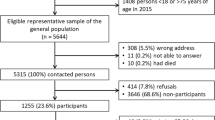Abstract
Purpose
To investigate the association between smoking and health-related quality of life (HRQOL) in a rural Japanese population.
Methods
A cross-sectional study of data from 823 subjects in Iwaki area of Hirosaki City, Japan. SF-36 scores between non-smokers and smokers were compared. To test the sensitivity of SF-36 scores in detecting health deterioration, effects of having diseases and having deviations from normal thresholds in health check-up were analyzed by adding them into covariates in ANCOVA.
Results
There was no significant difference in SF-36 scores between non-smokers and smokers. Presence of diseases significantly decreased the physical components of SF-36 scores while the results of health check-up had no significant influence on SF-36 scores.
Conclusions
The results suggested the possibility that in Japan, where smoking prevalence is still relatively high, smokers may be less sensitive to sub-clinical deterioration in their own health status than smokers in Western countries that already have experienced the major decline in their smoking rate. The importance of having the smoker become more sensitive to the sub-clinical adverse effects of cigarette smoking should be stressed for the success of smoking control programs.
Similar content being viewed by others
Abbreviations
- ANCOVA:
-
Analysis of covariance
- BMI:
-
Body mass index
- BP:
-
Bodily pain
- GH:
-
General health perception
- HRQOL:
-
Health-related quality of life
- MCS:
-
Mental component summary
- MH:
-
Mental health
- PCS:
-
Physical component summary
- PF:
-
Physical functioning
- RE:
-
Role emotional
- RP:
-
Role physical
- SF:
-
Social functioning
- VT:
-
Vitality
References
World Health Organization. (2006). World health report 2006. Geneva: World Health Organization.
Summary of the life table for each prefecture 2005 [Web page]. Statistics and information department, Ministry of Health, Labor and Welfare of Japan. http://www.mhlw.go.jp/toukei/saikin/hw/life/tdfk05/02.html. Accessed November 8, 2009 (In Japanese).
Kamata, A., Watahiki, N., & Nishida, S. (2000). A study of life expectancy at birth in Aomori Prefecture. Bulletin of National Institute of Public Health, 49(1), 62–71 (article in Japanese).
Japan Health Promotion & Fitness Foundation. (2000). Healthy Japan 21 (Movement for national health promotion in 21st century). Tokyo: Taiyo Bijutsu (in Japanese).
Wilson, D., Parsons, J., & Wakefield, M. (1999). The health-related quality-of-life of never smokers, ex-smokers, and light, moderate, and heavy smokers. Preventive Medicine, 29(3), 139–144.
Laaksonen, M., Rahkonen, O., Martikainen, P., Karvonen, S., & Lahelma, E. (2006). Smoking and SF-36 health functioning. Preventive Medicine, 42(3), 206–209.
Mulder, I., Tijhuis, M., Smit, H. A., & Kromhout, D. (2001). Smoking cessation and quality of life: The effect of amount of smoking and time since quitting. Preventive Medicine, 33(6), 653–660.
Tillmann, M., & Silcock, J. (1997). A comparison of smokers’ and ex-smokers’ health-related quality of life. Journal of Public Health Medicine, 19(3), 268–273.
Olufade, A. O., Shaw, J. W., Foster, S. A., Leischow, S. J., Hays, R. D., & Coons, S. J. (1999). Development of the smoking cessation quality of life questionnaire. Clinical Therapeutics, 21(12), 2113–2130.
Michael, Y. L., Colditz, G. A., Coakley, E., & Kawachi, I. (1999). Health behaviors, social networks, and healthy aging: Cross-sectional evidence from the Nurses’ Health Study. Quality of Life Research, 8(8), 711–722.
Borzecki, A. M., Lee, A., Kalman, D., & Kazis, L. E. (2005). Do poor health behaviors affect health-related quality of life and healthcare utilization among veterans? The Journal of Ambulatory Care Management, 28(2), 141–156.
Matsushita, T., & Matsushima, E. (2004). Quality of life and lifestyle among city dwellers participating in the medical programs. Psychiatry and Clinical Neurosciences, 58(6), 642–650.
Kimura, T., Ogushi, Y., Takahashi, M., Munakata, Y., & Ishii, S. (2004). Association of health-related quality of life with health examination including organic functions and lifestyles in Japanese employees. Quality of Life Research, 13(2), 519–529.
Kimura, T., Ogushi, Y., Haruki, Y., & Okada, Y. (2000). Is interest in art effective in health-related quality of life?–Results of a cross-sectional survey on lifestyle and health promotion. The Tokai Journal of Experimental and Clinical Medicine, 25(3), 141–149.
Ware, J. E., & Sherbourne, C. D. (1992). The MOS 36-item short-form health survey (SF-36). I. Conceptual framework and item selection. Medical Care, 30(6), 473–483.
Fukuhara, S., Bito, S., Green, J., Hsiao, A., & Kurokawa, K. (1998). Translation, adaptation, and validation of the SF-36 Health Survey for use in Japan. Journal of Clinical Epidemiology, 51(11), 1037–1044.
Fukuhara, S., Ware, J. E., Kosinski, M., Wada, S., & Gandek, B. (1998). Psychometric and clinical tests of validity of the Japanese SF-36 Health Survey. Journal of Clinical Epidemiology, 51(11), 1045–1053.
Fukuhara, S., & Suzukamo, Y. (2004) Manual of SF-36v2 Japanese version. Kyoto: Institute for Health Outcome & Process Evaluation Research (in Japanese).
National census 2005 [Web page]. Statistic Bureau Japan Web site. http://www.e-stat.go.jp/SG1/estat/eStatTopPortal.do. Accessed November 8, 2009 (in Japanese).
Health and welfare department, Aomori Prefecture. (2007). Healthy Aomori 21 revised version (p. 44). Aomori: Health and welfare department, Aomori Prefecture (in Japanese).
World Health Organization. (2008). WHO report on the global tobacco epidemic, 2008: The MPOWER package. Geneva: World Health Organization.
Lopez, A. D., Collishaw, N. E., & Piha, T. (1994). A descriptive model of cigarette epidemic in developed countries. Tobacco Control, 3, 242–247.
Kaneita, Y., & Oida, T. (2006). Smoking behavior and attitude towards smoking among the members of the Japan Medical Association. Journal of Japanese Circulation Society, 14(2), 335–340.
Acknowledgments
The authors would like to thank Dr. Kazuo Sugawara, former professor at the Department of Hygiene, Hirosaki University School of Medicine for his kind assistance and useful suggestion during the design of this study and the preparation of the manuscript. This work was supported by a grant-in-aid for scientific research from the Ministry of Education, Culture, Sports, Science and Technology of Japan (No. 18200044).
Author information
Authors and Affiliations
Corresponding author
Rights and permissions
About this article
Cite this article
Funahashi, K., Takahashi, I., Danjo, K. et al. Smoking habits and health-related quality of life in a rural Japanese population. Qual Life Res 20, 199–204 (2011). https://doi.org/10.1007/s11136-010-9748-8
Accepted:
Published:
Issue Date:
DOI: https://doi.org/10.1007/s11136-010-9748-8




